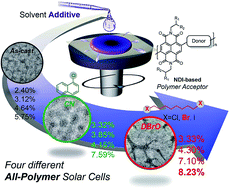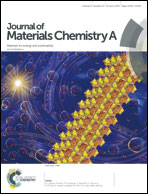Engineering the morphology via processing additives in multiple all-polymer solar cells for improved performance†
Abstract
In this contribution, we report the working mechanisms of several processing additives for controlling the morphology of four all-polymer systems. The optical and electrical properties, photovoltaic performance, morphology and the dynamic process of film formation of these all-polymer systems were thoroughly examined. We revealed that the effect of additives is largely dependent on the aggregation behaviors of the polymers used. Here, the polymer acceptors with large planar structures have stronger inter-chain interactions, which make their morphology more susceptible to additive treatment compared to the donors. 1,8-Di(R)octane (R = Cl, Br, and I) additives can be applied to multiple all-polymer devices with improved efficiency due to their general capability to increase the crystallinity and extend the effective time during the film formation. Interestingly, DBrO outperforms the widely used DIO, obtaining a highest efficiency of 8.23% for the PTzBI/P(NDI2OD-T2) based all-polymer solar cells, indicating finer morphology control by a subtle change of the additive structure. In contrast, the addition of chloronaphthalene (CN) can alleviate the inter-chain interaction of polymers to prevent the formation of oversized domains, which make it especially efficient for systems using strongly aggregated polymers like P(NDI2OD-T2). Our results provide insight into processing additives and suggest guidelines to rationally select additives for nonfullerene solar cells.



 Please wait while we load your content...
Please wait while we load your content...